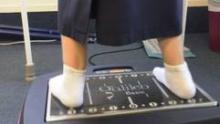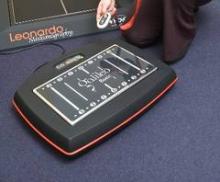SAN FRANCISCO – Regular sessions on vibration platforms improved bone density, muscle mass, and walking ability in children with cerebral palsy in a small study from New Zealand.
Five boys and eight girls aged 14-19 years with moderate cerebral palsy had four sessions per week in which they stood on the platforms for 3 minutes, took a 3-minute break, and repeated the cycle twice more.
After 5 months, their mean total leg bone mineral density (BMD) increased from 1.06 g/cm2 to 1.08 g/cm2, their total spine BMD increased from 1.01 g/cm2 to 1.02 g/cm2, and their total lower-tibia volumetric BMD increased from 607 mg/cm3 to 690 mm/cm3. These modest changes were similar to those seen with osteoporosis medications.
The subjects’ mean midtibia muscle cross-sectional area increased from 3,163 mm2 to 3,440 mm2, and their mean 6-minute walk distance increased from 286 to 314 m. The results were all significant. One girl was able to walk up stairs for the first time after the trial, and was still able to do so 6 months later, according to lead investigator Silmara Gusso, Ph.D., a research fellow at the University of Auckland, New Zealand.
Parents reported fewer falls at home, better balance, and more regular bowel function. Several said they wanted to buy one of the devices, a Galileo home vibration platform. Physiotherapists said they wanted to try them on children with other musculoskeletal challenges, Dr. Gusso said at the Endocrine Society’s Annual Meeting.
"We were quite surprised to see the changes over such a short period of time ... [and] very impressed with the feedback we got from families, physiotherapists, and the kids themselves," who "opened huge smiles" when they stepped on the platforms. It was all "much more than we expected. We are quite excited about it," she said.
Vibration platforms aren’t new; they’ve been used before to help with osteoporosis, surgery recoveries, and athletic injuries.
The trial may be the first, however, to try them for cerebral palsy. The idea was to see if they’d help with osteopenia and muscle mass, something that’s hard to address with standard physiotherapy, which focuses on strength, stretching, balance, and gentle walking, Dr. Gusso said.
The platforms were set to tip side to side at 1,200 oscillations per minute (20 Hz), "which is pretty hard exercise" even for someone without cerebral palsy. The children had a brace they could hold on to for balance. Their weekly physiotherapy sessions continued throughout the study.
The research will be expanded to include children with other disabilities. "It’s a small and simple device that can bring extra benefits" to standard approaches, Dr. Gusso said.
Dr. Gusso and her team said they had nothing to disclose. The work was funded by the Jubilee Trust, the Australasia Paediatric Endocrine Group, and others.



